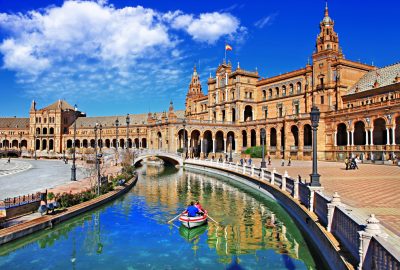Seville (Sevilla in Spanish) is not only the capital of Spain's southernmost and autonomous region Andalusia. Sevilla is also the quintessential city for everything Spanish. It’s pocket Spain. The flamenco, the bullfighting, the tapas, the nightlife; it’s all there. What makes Seville distinctly unique is its rich history. Legend says that Hercules founded the city. It went through major development when Romans conquered the region. You can see what remains of those times in the Antiquarium; an underground exhibition below the Metropol Parasol. The Moors took over Seville in the year 712. That’s when it started to bloom with a beautiful Muslim aesthetic. It’s not really Muslim, it’s Christian made to look Muslim, go figure. Mudéjar is the actual name of that style and the Alcázar is its best representation. A former Moorish fortress turned into a royal palace following the Christian conquest of Seville. The entire complex is stunning. You can explore multiple courtyards with arcades and fountains. There are 13 gardens around the Alcázar. Everything has a purpose here. They needed so many gardens and fountains because it gets ridiculously hot during the summer. The absolutely massive Seville Cathedral stands next to the Palace. It’s so big that people joke around about fitting a football stadium inside. Its development over 300 years is a reflection of Seville’s cultural transformation. Arabs built it as the main mosque in this region. The Giralda tower is one of the minarets that remained from that era. Then Christians converted everything into a church following the conquest. The final stage of making it one of the most ridiculous cathedrals in the world happened when Spain got super-rich super-fast.

Bullfighting has a long tradition in Seville and other Spanish cities, according to some graceful art, comparable to ballet and the embodiment of Spanish passion, according to others it embodies the pinnacle of animal cruelty, probably it's only a matter of time until it will face a total ban
That enormous flow of money came from newly established colonies. Most big boys of the Age of Exploration can be traced back to Seville. Even Columbus’ body rests in a tomb in the Cathedral. The city got huge and not only because it was the starting point of many voyages. Seville had a monopoly on everything that came in from South America. You can learn more about all that in the General Archive of the Indies. It used to be the headquarters of the Merchants Guild, now it stores all the documents. That building stinks of money. All the ships that set sail from Seville towards the New World had to navigate the Guadalquivir, one of the longest rivers of Spain. It’s about 130 kilometres distance to the Atlantic. The river has to be wide and deep enough for large vessels to navigate. Especially back then when they didn’t have sat-nav. The Maria Luisa Park (Parque de María Luisa) is Seville’s main garden area, also located along the Guadalquivir. I have to say it’s one of the most beautiful places I’ve ever been to. Almost like a completely separate entity from the core of the city. You will need a map because this place is labyrinthine. Try not to get lost and you’ll hopefully arrive at the Plaza de España. Can’t miss it because it’s also a huge, open space with enchanting Mudejar architecture.

Plaza de Espana, one of the most impressive places in Seville and completely unique in construction, the square was built for the Ibero-American Exhibition of 1928
Check out the old Jewish Quarter and experience a different face of Seville. It’s called the Barrio de Santa Cruz now, but it was a Judería in medieval times. You’ll want to spend a lot of time here if you visit Seville in summer. Why? Because of all the shade. Buildings are so close to each that people could shake hands standing on opposite balconies. Streets are so narrow that cars can’t drive through, so it’s only open to pedestrians. This is the place for a have a cup of coffee or shameless day drinking. There’s nothing better than a cold brew under one of many orange trees. Don’t eat the oranges; they’re disgusting. They’re what the English make their bitter orange marmalade from. Locals use the peels and fruit to make essential oils and perfume. Those are sold alongside traditional fans and clothing. All that adds up to the Spanish temperament and nothing brings it out more than Flamenco. It originates from Andalusia and is a pillar of Sevilla’s nightlife. It is a literal nightlife; people eat dinner around 10 PM here. So, the partying doesn’t start before midnight and often lasts until 7 in the morning. You’ll find a number of flamenco joints and bars along the Guadalquivir. Calle Betis street is particularly popular with the party community.



No one commented yet. Be the first.